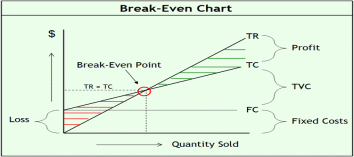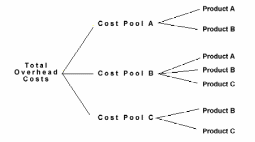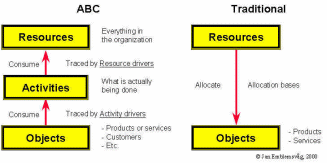Introduction
Cost management is a strategic management tool that looks into the best approaches to minimize costs and maximize profits within a business. It focuses on the impact of current or proposed decisions on the future of an organisation; cost management main aim is to assist organisations to make such strategic costing, pricing, and selling approaches that help to create more customer value at lower costs (Horngren, 2009). The indirect approach fulfils profit making firms main objective of maximizing profits and growing shareholders wealth. To manage costs effectively, leaders establish different costing heads that they use to classify, monitor, and control the associated costs; in the manufacture of products and services, costs can be classified as either direct or indirect costs (Warren, James and Duchac, 2008).
Types of costing methods
Costs can generally be classified as direct and indirect costs; direct costs are those costs that are only incurred when business is ongoing: this means when services and goods are being produced. For instance, when Nokia Corporation is making a certain model of phone, there are the software, handset, direct labour, direct materials, and other direct costs that must be attributed to the manufacture of such a product. The total of those costs are classified as direct costs; when establishing the price of a product, such costs will be considered to form part of the price of the commodity. Direct costs are also referred to as traceable costs since they can easily be ascertained that they occurred for the sake of the products or service manufacture.
Indirect costs are expenses incurred within a company however they cannot directly be traced concerning a plant, product, process or department; they are expenses that assist in the smooth operation of a firm; they cannot be said they occurred because of ascertaining production. Within the frameworks of indirect costs, there are fixed indirect costs, sunk indirect costs, indirect overhead costs, opportunity costs, and economic costs. Fixed costs are incurred whether a business is in operation or not, while other indirect costs can be attributed to costs that are incurred by the virtue that a company is operating. For example, for Nokia to continue the business, it has to maintain an effective management system, has to have administration costs, and had invested in assets. The above are some of the costs that are crucial for the smooth operation of the firm however they cannot be attributed to a specific model of phone.
When determining the costs incurred for certain products, management accountants apportion the indirect costs and attribute every cost to specific products, the final costs incurred is calculated as follows:
Total product cost = fixed costs + portion of indirect costs
Management accountants need to calculate the number of products that need to be produced by a firm to cover its costs as well as the ones needed to make a certain profit, project managers use breakeven methods; it can be calculated using mathematical interpolations as well as through the use of a diagram. The diagram below shows how a breakeven point can b calculated by a graph:

To determine how costs will be allocated to different commodities, departments or activities within an organisation, management accountants have various costing methods they can adopt for the task; the most common methods are standard costing, activity-based costing and batch costing.
Costing methods
Depending on the nature of one’s trade, and the industry, different companies choose the costing method that will allow allocation of expenses effectively; an effective system sets prices that will allow an improved value to customers at the most affordable cost. The most affordable cost does not necessarily mean cheap cost but portrays value for money. For instance, Southwest Airlines is a low-cost airline company that aims at reducing the expenses and improving the efficiency of its services to be able to charge relatively low; however other companies in the airline industry still maintain the conventional airline system where prices are pegged to the class and comfort of the airline (Jiambalvo, 2007). The following are the methods of costing available for use by various companies:
batch costing/ Standard costing
Under this method, fixed costs and other indirect costs are attributed to a certain time or unit of production; then when accounting for the costs, they are proportional to the number of products that have been produced in that particular period. Companies that have production of large units taking a specific time are situated to use this method; for example, when Airbus is making say Boeing 780 planes, the management has a unit that will deal with the production; if the fixed costs used to make two planes are $50 million and directs costs used per plane are $45 million, then when costing the cost of an aeroplane will be $25 + $45= $70 (Bragg, 2001).
activity-based costing
Under the system, the costs associated with a certain product is calculated by addicting up the apportionment of the costs of all activities that have been incurred in the production of the commodity. Under the system, every cost that has been incurred that can be attributed to certain sections, departments or activity is considered to be a cost of the products as a result (Carter, 2005). The method is more common in those companies that produce different products under the same roof; for example, Samsung may incur some research and development costs to advise on the best products that they should undertake; however, when though the costs are incurred for the benefit of the entire company, there may be more costs attributed to the research of the performance of laptops than phones. The idea behind activity costing is that the company will apportion the costs and attribute those associated with laptops to laptops and have the portion on phones the same. The method is superior as it does not assume that the cost is common thus should be attributed to all commodities at the same rate (Jawahar, 2008). (Please see appendix 2 for a comparison of ABC and traditional form of costing)
The importance of using an appropriate costing method
Different industries call for the use of different costing methods depending on their nature of trade, however, despite the differences, the most important parameter to consider is whether the method adopted adds value to customers and leads to overall cost-effectiveness in a company. Costing methods are used to control, monitor, and attribute costs to different departments, products or activities within an organisation. When well-managed, an organisation can realize areas that are cost-ineffective and develop appropriate strategies to address the issues (Weygandt, Kimmel and Kieso, 2009).
Demonstration of costing method adopted using batch costing
In this segment, the paper will make an illustration of how Airbus attributes costs to different products; in this case, we consider the manufacture of Boeing 780 that are produced using in batches of three:
Fixed costs as a result are:
Fixed costs are costs that do not relate to any production but exists as long as a business is there. They include license fees, rent, management salaries and security costs among others. When calculating the cost of an item, they are spread all over the products produced to determine the particular cost. The following are the fixed costs (in millions) that will be incurred in the project:
- administrative expenses = $20
- Factory rent = $20
- Legal fees and licenses = $80
- Utilities = $20
- Insurance = $30
- Payroll salaries= 100
Total fixed costs for making three Boeing 780 are $270 million
The following are the variable costs (for each plane) that will be incurred:
- Costs of direct labour, professional fees and casuals costs = $400
- Cost of materials = $500
- Transporting costs= $100
The total variable costs of the plane are $1000 million.
When calculating the cost attributed to the production of the plane, then it will be calculated as follows:
(Total costs/3) + Total variable costs = $270/3+ $1000 = $1,070 Million.
(Maher, Stickney and Roman, 2006)
Demonstration of Costing using activity-based costing
In this case the paper will show how costs will be attributed to both laptops and phones produced by Samsung:
Assume the following are the costs:
- Phones
- Laptops $200
- Variable costs $20
- Research costs $100
- Labour costs $200
- Transport cost $10
Assuming that the usage on research costs, labour costs and transport costs can be divided into the ratio of 2:8 4:6 and 5:5 for phones and laptops respectively, then the cost of the products will be:
Phone: ($20+2/10*100 + 4/10*200 + 5/10*10) = $125
Laptops: ($200+8/10*100+6/10*200+5/10*10) = $405
(Please see appendix 1 for an analysis of stages that division of costs can take using cost heads)
Demonstrate how data related to these costs is collected, analysed and presented for management accounting purposes
There are numerous sources of costing information; the sources can generally be classified as internal sources and external sources; under internal sources, the consideration is on past experiences and performances of the organisation. This can be derived from routine reports, manufacturing reports, and stock movement sheets. When the information has been documented, then the management can get the ideal situation or standard costs to use when making costing decisions (Jiambalvo, 2007).
External sources of information come from organisations both governmental and non-governmental that give information on a particular area of interest to management. The most important aspect to consider when using external sources of information is their integrity; external information should be vetted for the same (Ray. Eric, and Brewer, 2009)
Conclusion
It is the role of management to make policies that lead to effective cost management within their organisations; depending on the nature of trade, industry, economic, social, and political environment the costing method adopted by a firm varies. The most crucial aspect that managers should consider is how well costs are covered by-products or services produced. Effective cost management strategy should endeavour at maximizing profits, improving customer satisfaction, and reduce operational costs.
References
Bragg, M. (2001). Cost accounting: a comprehensive guide. New York: John Wiley and Sons.
Carter, K. (2005). Cost Accounting. New Jersey: Cengage Learning.
Don, R. and Mowen, M. (2006). Managerial Accounting. New Jersey: Cengage Learning.
Horngren, T. (2009). Cost accounting: a managerial emphasis. Pearson Prentice Hall.
Jawahar, L. (2008). Cost Accounting. New Jersey: Tata McGraw-Hill Education.
Jiambalvo, J. (2007). Managerial Accounting. New York: John Wiley and Sons.
Maher, M., Stickney, P. and Roman, L. (2006). Managerial accounting: an introduction to concepts, methods, and uses. New Jersey: Cengage Learning.
Ray, H., Eric, W., Brewer, P.(2009). Managerial Accounting London: McGraw-Hill/Irwin.
Warren, C., James, M. and Duchac, J.(2008). Managerial Accounting. New Jersey: Cengage Learning.
Weygandt, J., Kimmel, P. and Kieso, D. (2009). Managerial Accounting: Tools for Business Decision Making. New York: John Wiley and Sons.
Appendixes
Appendix 1: allocation of costs on a cost pool basis

Appendix 2: comparison o Activity-based costing with traditional costing methods

